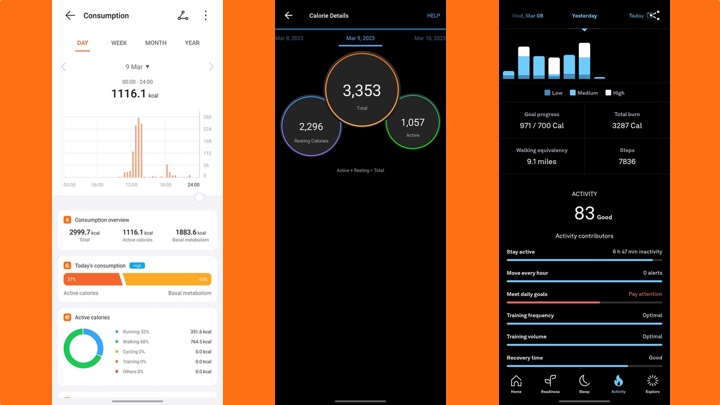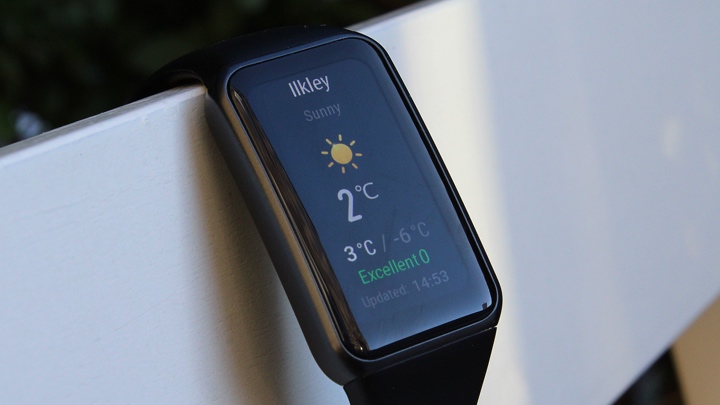
- Good enough for basic tracking
- Solid battery life even with AOD
- Design is simple and comfortable
- Essentially identical to Band 6
- Hit-and-miss heart rate monitoring
- Honor Health app is glitchy
The Band 7 is not an ambitious leap forward by Honor, with the company seeming content to slap a new title on the last-gen model in order to meet its biennial update cycle.
But despite the lack of improvements over the Honor Band 6 released in 2021 - and there are very few - this is still one of the better budget fitness trackers around.
It continues the new breed of fitness bands adopting more of a smartwatch case shape, and features like the AMOLED display and reasonable breadth of tracking mean it's certainly punching above its price tag.
We've been putting it under the microscope over the last couple of weeks - here's what we've found.
Design and display
Wareable
With the Band 7, you get the same 1.47-inch AMOLED display that popped in the last generation; it's a really attractive equivalent to the screens of fitness trackers past, and the UI is impressively responsive.
In fact, we should point out that the Band 7's similarities don't end with the last generation, either. Despite the fact Honor is no longer a Huawei subsidiary, the former is still taking plenty of inspiration from its old owner's trackers - in this case, the Huawei Band 7.
It is slightly thicker than the latest Huawei tracker, though, measuring in at 11mm - and the weight is also 18g.
After a couple of weeks of use, we've been impressed with how comfortable the Band 7 is for round-the-clock wear. It's not the most premium feeling, obviously, with that case still just being made from basic TPU, but it's still very light and unobtrusive.
Wareable
The side pusher also remains on the case's right side, essentially acting as your return button. Otherwise, you'll be tapping and swiping for navigation. Handily, the display doesn't really pick up fingerprints too excessively, and visibility in brighter conditions is still very good.
Honor has also removed the brand stamping that was previously on the left side of the Band 6, which is a bit nicer.
For anybody interested in showering or pool swims with the Band 7, we should also point out that it's tagged with a 5ATM rating - meaning it should be able to withstand pressures equivalent to 50m depth.
We've highlighted the potential for variance in such ratings in our guide to water resistance ratings, but, really, this should be fine for short bouts in the water. And, at least in our case, we've had no issues with screen steam or any other damage after wearing the Band 7 in the shower during testing.
All in all, then, the design ticks the same boxes as it did back in 2021. It's disappointing that Honor hasn't moved things on and perhaps upgraded the case material or display size, but, for the price, we don't think you can find many better designs.
Daily activity and sleep tracking
Wareable
Like any device at this price range, the Band 7 is built for the basics - step tracking, sleep monitoring and calorie burn estimates.
Unlike with the last generation, this is all then presented in the Honor Health app, as opposed to Huawei's equivalent.
Step tracking
The estimate of your distance and steps covered comes from the internal accelerometer and gyroscope motion sensors, and, compared to the Garmin device we tested it against, it matches up pretty well.
It has a very slight tendency to overreport steps, but this is nothing drastic in comparison to the wild fluctuations you can get from some cheaper devices.
Wareable
It's also nicely presented in the companion app, giving you breakdowns of your steps over multiple periods and comparisons to the previous week.
Sleep tracking
Sleep monitoring accuracy is a similar story, which is encouraging.
While sleep stages and sleep scores were sometimes way out when compared to the Oura Ring Gen 3 Horizon and Whoop 4.0 - two devices we consider to be at the peak of wrist-based sleep tracking - it was able to reliably give an indication of the time we fell asleep and woke up.
And given the fact we don't tend to put too much stock into sleep stage accuracy, we think this Band 7 is more than good enough at this price.
Wareable
The data in the app is pretty sloppy, though - noting our bedtime as around 3pm and wake time as 1am. Still, you're still able to figure this out and get the correct info when zeroing in on specific days.
Calorie burn estimates
Total calorie estimates also manage to live in a steady range. Again, this figure is generally very variable between devices due to how a company chooses to track it, and it's certainly just an estimate, but the Band 7's data is right among much more expensive options.
Garmin and Oura, as shown below, add tracked exercise calorie burn onto your Active Metabolic Rate (AMR), while Honor uses the method of taking your Basal Metabolic Rate (BMR) from personal info like age, height and weight and then adding active calories on top.
Wareable
While the method is sound in either case, we should note that this is obviously very contingent on accurate heart rate monitoring, which we'll come onto below.
For most days, at least, the Band 7 was capable of delivering a solid calorie burn estimate within 100-200 of the devices we tested it against.
Heart rate monitoring
Wareable
Heart rate monitoring is often the area in which budget devices can fall down, and the Band 7, despite its successes in other areas, isn't the most reliable option you're going to find.
Like with the rest of the experience, though, it's certainly good enough for getting a general gauge - whether that's in the background monitoring, specific tracking during exercise or in health measurements like blood oxygen saturation.
Continuous heart rate tracking
Wareable
The Band 7's background heart rate monitoring is pretty solid - again, without being spectacular. It's presented in a similar way in Honor Health to how you would find it in something like Apple Health, with heart rate ranges, average resting heart rate and a breakdown of your minutes in each heart rate zone all displayed.
Resting heart rate figures appear sky-high at first glance, though Honor does take this figure slightly differently from most companies. Instead of taking your sleeping average, or your lowest heart rate figure during sleep, Honor instead takes your average beats during inactive awake hours.
We don't necessarily prefer this reading, as it doesn't really give you an indication of how recovered you may or may not be, but you do at least get your lowest HR from a 24-hour period to get some insight into this.
Exercise heart rate monitoring
Wareable
While the Band 7 certainly holds its own in some tracked sessions, this is where it would also face some serious difficulty.
Unusually, it would often take anywhere from 5-15 minutes to 'warm up' and then suddenly spike, as shown above. This particularly occurred in sessions in which our heart rate started low, such as in strength training, but it did also occur on a couple of outdoor runs, too.
Then there were other occasions - ones in which the heart rate monitor was able to pretty reliably match up to Garmin's v4 Elevate sensor. It also didn't seem to make too much difference whether this was steady monitoring or reacting to interval fluctuations, as shown below.
Wareable
Here, it aptly recorded around 25 minutes of steady monitoring before performing very well when we threw a few one-minute sprints at it.
It's just a shame, obviously, that this kind of performance wasn't present in every session - and it does have a bit of a knock-on effect on things like calorie burn estimates, as we mentioned above.
Continuous SpO2 monitoring
Wareable
This would have been a feature exclusive to the Band 7, except the Band 6 received a post-launch update that meant the SpO2 monitoring transformed from on-the-spot to continuous.
As shown, readings are primarily taken continuously throughout the night and then the odd reading is taken throughout daytime hours.
Like with other methods Honor uses, we don't necessarily love this, as sporadic daytime reading (when your wrist is likely to be moving around much more than during sleep) can really skew daily averages, but the results did mostly match up to Garmin.
Smartwatch features
Wareable
While we initially anticipated an improvement in the smartwatch features offered through the Band 7, with contactless payments and a bump up to Bluetooth 5.2 touted upon the release in China back in December, this doesn't appear to have transferred itself to the international version.
Again, this means you're dealt an almost identical hand to the Band 6 - even if that's not necessarily a bad thing. The real bonus is that there's now an always-on display (AOD), which is still a bit of a rarity at this price point, and it's also backed up by decent notification support, live weather information and the ability to set timers and alarms.
None of it is especially exciting, but, as we mentioned with the Band 6, the display does mean that these basic features shine. We just wish it was bolstered by proper music control (this is still just reserved for Android phones, though the Band 7 is also iOS-compatible) or the odd app.
Battery life
Wareable
Now that Honor has installed an always-on display function, the battery life you can expect really depends on whether you have this turned on or off.
Like before, the company still estimates that you'll receive around 14 days of life from the 180mAh battery unit packed inside. And even though things haven't progressed in this generation, that still compares pretty well to the rest of the options on the market.
With the AOD turned off, SpO2 turned on and around 60-90 minutes of tracked activity per day, we've found this is actually a bit closer to nine days of battery life, but, keep in mind, Honor's estimate only accounts for one 30-minute exercise per week.
This naturally dips dramatically if you turn the AOD on, and we found that this, combined with max brightness settings, sees the device's battery dwindle by around 25-30% each day.
The nice thing about the Band 7 is that there's plenty of choice, and you still get a good number of days even at roughly close to its maximum capacity. We even think that you could stretch things way beyond 14 days with a few of those features turned off, which is good news for those whose priority is longevity.
Charging is pretty incredible, however, giving you a 0-20% charge in around five minutes.
How we test
